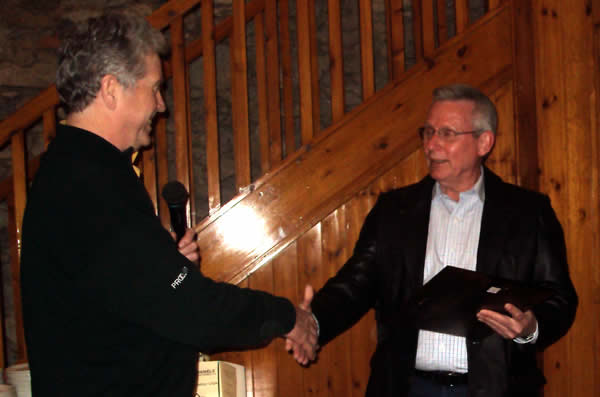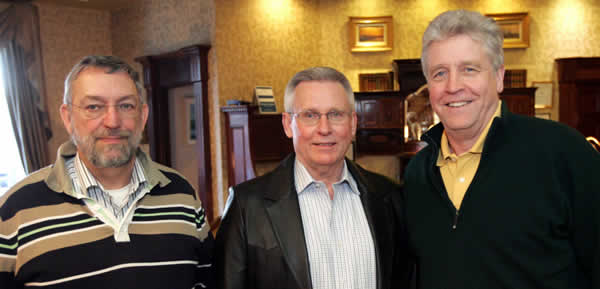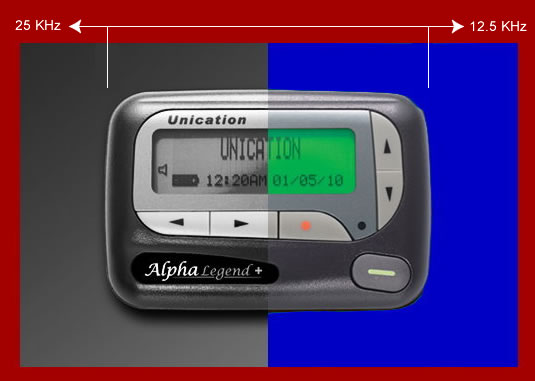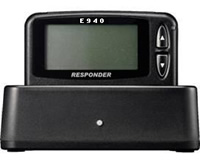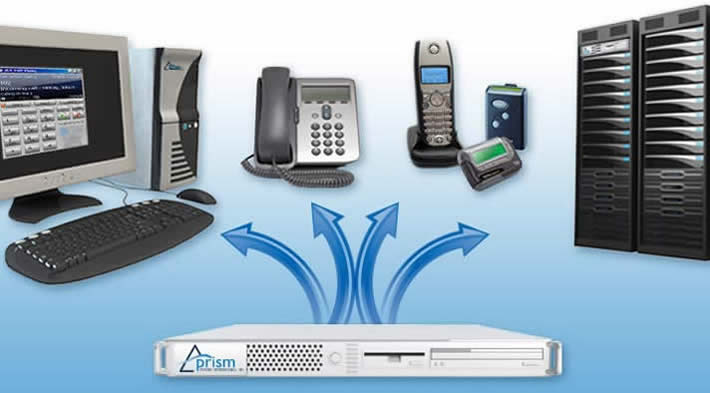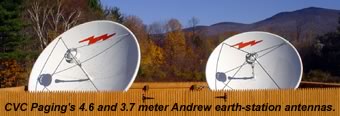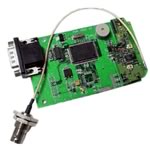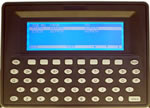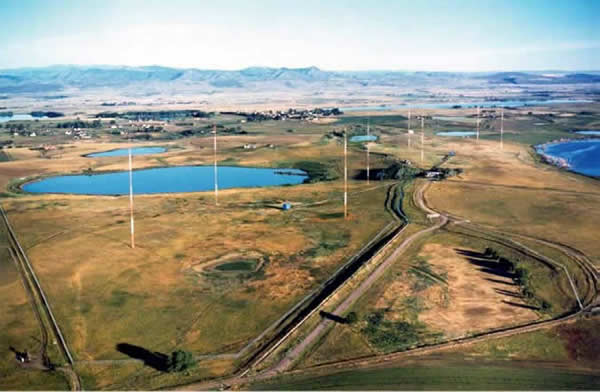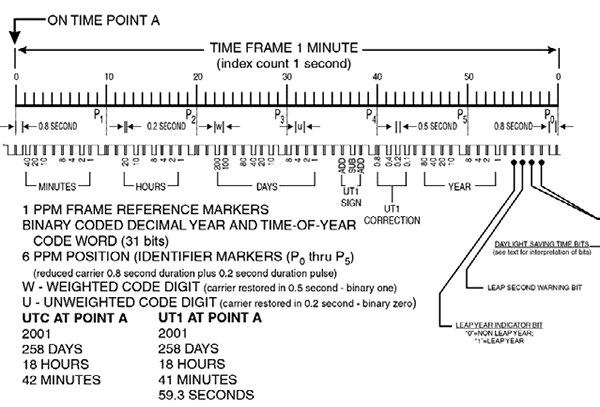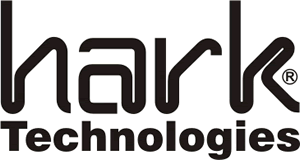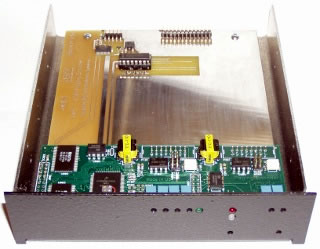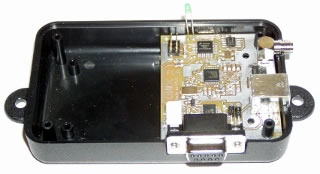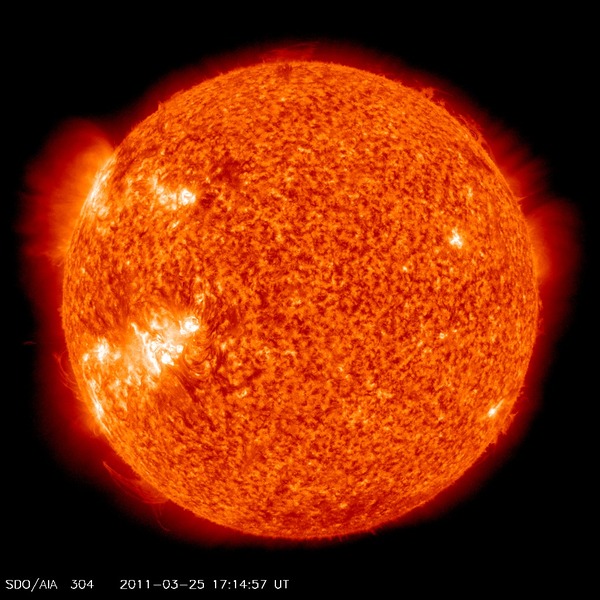BloostonLaw Telecom Update Published by the Law Offices of Blooston, Mordkofsky, Dickens, Duffy & Prendergast, LLP [Portions reproduced here with the firm's permission.] www.bloostonlaw.com |
| Vol. 14, No. 13 | March 30, 2011 |

INSIDE THIS ISSUE - Comment dates set for NPRM on retransmission consent negotiations.
- FCC sets schedule for 2011 annual access tariff filings.
- 700 MHz performance status reports due by June 13.
- CTIA, RCA ask FCC to prohibit, freeze licensing on TV channel 51.
- Comment sought on draft environmental rules affecting antenna registration program.
|
Clients Urged To Be Counted On VoIP, Phantom Traffic Comments In USF/ICC Reform Proceeding BloostonLaw, on behalf of its clients, the “Blooston Rural Carriers,” is preparing to file comments due April 1) asking that the FCC: (1) declare that interconnected Voice over Internet Protocol (VoIP) traffic is subject to the same intercarrier compensation rules, obligations and charges as other voice telephone service traffic; and (2) amend its rules to resolve the “phantom traffic” problem by ensuring that all service providers receive sufficient information associated with each call terminated on their networks to identify the originating provider and location for the call. The comments are in response to Section XV (“Reducing Inefficiencies and Waste by Curbing Arbitrage Opportunities”) of the Commission’s Notice of Proposed Rulemaking (NPRM) and Further Notice of Proposed Rulemaking (FNPRM) regarding intercarrier compensation (ICC) and Universal Service Fund (USF) reform (BloostonLaw Telecom Update, February 9 and 16). All affected telecom carrier clients are urged to participate in these comments, since this is clearly a “stand up and be counted” proceeding with potentially significant consequences for the rural telecom industry. Please let us know if your company wishes to participate in the attached comments by Friday, April 1 at noon. The Blooston Rural Carriers argue that allowing continued avoidance or evasion of applicable access charges and reciprocal compensation by VoIP service providers and by the wireless and wireline purveyors of “phantom traffic” violates competitive and technological neutrality. Because they pay nothing for their use of “last mile” networks, VoIP providers and “phantom traffic” purveyors have been able to seize for themselves substantial cost advantages over traditional long distance toll carriers and other service providers that accurately identify their traffic and pay the appropriate intercarrier compensation charges for it. These unwarranted and unfair cost evasions have enabled VoIP providers and “phantom traffic” purveyors to charge artificially low prices for their services, and to grab large numbers of customers and major portions of market share from competing service providers that play by the rules. Further, the Blooston Rural Carriers say: In addition to unjustly and unreasonably tilting the competitive balance in the interexchange service industry in favor of those who unilaterally “reduce” their intercarrier compensation costs, the current VoIP traffic and “phantom traffic” situation: (a) reduces incentives to invest in expensive “last mile” facilities (last 10-, 25- or 50-mile facilities in many rural areas); and (b) unfairly shifts the burden of paying the cost of terminating VoIP and “phantom traffic” calls onto consumers who do not use such services. Why should incumbent and competitive local exchange carriers obtain loans or raise equity in order to invest millions of dollars in the construction, extension and upgrade of their “last mile” networks when VoIP providers and “phantom traffic” purveyors are able to use such networks for free? What is the incentive to invest in capital-intensive “last mile” networks if the Commission is going to continue to allow VoIP providers and “phantom traffic” purveyors to grab substantial revenues, profits and market share by “free riding” on those networks? Equally unjust and unreasonable, the Blooston Rural Carriers say, is the fact that incumbent local exchange carriers must recover from others the portion of their “last mile” network costs that should be paid by VoIP calls and phantom traffic. At the present time, these costs must be recovered: (a) from local service rates (paid in substantial part by customers that do not make or receive VoIP or “phantom traffic” calls); and (b) from federal or state high-cost support (raised in substantial part from contributions by customers that do not make or receive VoIP or “phantom traffic” calls). Simple equity requires VoIP providers and “phantom traffic” purveyors (and ultimately their customers) to pay appropriate intercarrier compensation for their use of “last mile” networks, rather than shifting the burdens of their shares of network costs onto local service customers and universal service contributors that do not use or benefit from VoIP and “phantom traffic.” VoIP Service Providers Should Pay the Same Inter-carrier Compensation Charges As Their Local and Toll Telephone Service Competitors The Blooston Rural Carriers note that some interconnected VoIP service providers claim that their lower charges are the result of their use of more efficient and less expensive technology than the old public switched telephone network. However, as the Commission is well aware, the old public switched telephone network no longer exists. Rather, it has been replaced by a multiple-use digital public communications network that has already evolved far down the path toward a national broadband network. Voice and data traffic has for years been originated and terminated over the same hybrid fiber-copper “last mile” facilities whether such traffic is classified as local exchange, long distance toll, interstate access, intrastate access, reciprocal compensation, VoIP or Internet traffic. Likewise, these multiple and varied classifications of voice and data traffic are digitized and/or packetized and carried over the same inter-city and inter-office trunk and transport lines. Finally, virtually all RLECs and other “last mile” carriers stopped buying new circuit switches years ago, and have steadily been deploying soft switches and routers to direct voice and data traffic to the appropriate destinations on their networks. Interconnected VoIP service providers do not use better technology than traditional wireline local exchange carriers and long distance toll carriers, the Blooston Rural Carriers point out. In fact, many interconnected VoIP service providers have not constructed their own local or long distance networks, or otherwise deployed substantial facilities or technology. Rather, the predominant reason why interconnected VoIP service providers are able to undercut the rates of existing local exchange and long distance toll service carriers is that they do not build and maintain their own networks, and/or they free ride on the networks of others by refusing to pay access charges or reciprocal compensation. Further, the Blooston Rural Carriers say: Many interconnected VoIP service providers currently evade or avoid payment of most intercarrier compensation because: (1) they do not properly identify themselves and/or the originating location of their traffic (i.e., they engage in the “phantom traffic” practices addressed in the next section of these comments); and/or (2) they refuse to pay for the use of “last mile” networks by their traffic on the alleged basis that they are not subject to access charges or reciprocal compensation. The Blooston Rural Carriers and other RLECs have been reluctant to block interconnected VoIP calls to their customers, and have not had the resources to identify and track down the many interconnected VoIP service providers terminating traffic on their networks and either sue them for unpaid services or try to negotiate interconnection or traffic exchange agreements with them. The Blooston Rural Carriers argue that the appropriate and effective solution is not the adoption of “bill and keep” for interconnected VoIP traffic. The Commission has long recognized that bill and keep arrangements between pairs of carriers are appropriate when their rates for terminating traffic are symmetrical, and when the volume of terminating traffic between the two service providers is approximately the same in both directions and expected to remain so.7At present, there is no evidence or indication that there is a roughly equal balance of terminating traffic between RLECs and VoIP service providers. In fact, most RLECs believe that they are terminating much more VoIP traffic than they are sending to VoIP service providers for termination. The appropriate and effective solution also is not a VoIP-specific intercarrier compensation rate such as $0.0007 per minute. For many RLECs, the costs of billing and collecting terminating charges exceed $0.0007 per minute. Even if a VoIP-specific intercarrier compensation rate would yield positive revenue net of billing and collection costs, it would encourage further arbitrage and disputes as carriers and service providers delivering all sorts of traffic for termination would have the incentive to claim that such traffic was “VoIP” traffic in order to pay the lower VoIP-specific rate. The only viable and competitively and technologically neutral solution is for VoIP service providers to be subject to the same access charges and reciprocal compensation rates as those paid by the local exchange carriers and long distance toll carriers against which they compete. The Blooston Rural Carriers ask the Commission to declare that VoIP traffic is subject under existing law to the same intercarrier compensation charges applicable to the long distance toll traffic and local traffic against which it competes. The Commission Must Revise Its Rules to Eliminate “Phantom Traffic” According to the Blooston Rural Carriers, “phantom traffic” is terminating traffic that cannot be identified and billed or billed accurately for access charges or reciprocal compensation because originating carrier and/or originating location information has been omitted, stripped or erroneously reported on the call records. As the Commission recognizes, “phantom traffic” is an improper attempt to avoid or reduce payments to the terminating service provider by misidentifying or otherwise concealing the source of the traffic. Without mincing words, the Blooston Rural Carriers say, “phantom traffic” is theft of service. It is no different from unauthorized reception of cable television service, credit card fraud, or driving off without paying for gasoline. In addition to amending its rules to ensure that all service providers receive sufficient identifying and originating information associated with each call terminated on their “last mile” networks, the Commission should sanction and fine service providers for engaging in unjust and unreasonable practices such as intentionally and/or repeatedly omitting, stripping or misidentifying such information. The Blooston Rural Carriers urge the Commission to take early and decisive action to adopt call signaling and call record requirements to address and eliminate the “phantom traffic” problem. These changes include early adoption of the NPRM proposals to: (a) amend the Commission’s call signaling rules to facilitate the transfer of information to determine the appropriate service provider to bill for all calls sent to the terminating “last mile” network (particularly where traffic is delivered through indirect interconnection arrangements); (b) require the calling party’s telephone number (“CPN”) to be provided by the originating service provider and prohibit the stripping or altering of call signaling information; (c) extend call signaling requirements to all traffic originating or terminating on the public network, including jurisdictionally intrastate traffic and VoIP traffic; and (d) clarify (consistent with industry practice) that populating the SS7 Charge Number (“CN”) field with information other than the charge number to be billed for a call is prohibited, and prohibit the alteration or stripping of signaling information in the CN as well as CPN fields. In addition, the Blooston Rural Carriers agree with the RLEC trade associations that the Commission should also: (1) include a requirement that providers transmit Carrier Identification Codes (“CIC”) or Operating Company Number (OCN) codes in addition to the CPN and CN in signaling information and/or billing records, as applicable; (2) clarify that providers may not substitute a number of a calling “platform” or “gateway” for the CPN or CN associated with the originating caller; (3) confirm that, in the absence of more accurate information or a governing agreement, terminating carriers may rely on the originating and terminating numbers of a call to determine jurisdiction for billing purposes; and (4) allow terminating carriers to charge their highest terminating rate to the service provider delivering unidentified traffic onto their networks. BloostonLaw contacts: Ben Dickens, Gerry Duffy, and Mary Sisak. Comment Dates Set for NPRM on Retransmission Consent Negotiations The FCC has set comment dates for its Notice of Proposed Rulemaking (NPRM), in which it seeks comment on a series of proposals to streamline and clarify the rules concerning retransmission consent negotiations. The Commission believes that these rule changes could allow the market-based negotiations contemplated by the statute to proceed more smoothly, provide greater certainty to the negotiating parties, and help protect consumers (BloostonLaw Telecom Update, March 9). Comments in this MB Docket No. 10-71 proceeding are due May 27, and replies are due June 27. The FCC says primary objective is to assess whether and how its rules in this arena are ensuring that the market-based mechanisms Congress designed to govern retransmission consent negotiations are working effectively and, to the extent possible, minimize video programming service disruptions to consumers. The Communications Act prohibits cable systems and other multichannel video programming distributors (MVPDs) from re-transmitting a broadcast station's signal without the station's consent. This consent is what is known as “retransmission consent.'' The law requires broadcasters and MVPDs to negotiate for retransmission consent in good faith. Since Congress enacted the retransmission consent regime in 1992, there have been significant changes in the video programming marketplace. One such change is the form of compensation sought by broadcasters. Historically, cable operators typically compensated broadcasters for consent to retransmit the broadcasters' signals through in-kind compensation, which might include, for example, carriage of additional channels of the broadcaster's programming on the cable system or advertising time. Today, however, broadcasters are increasingly seeking and receiving monetary compensation from MVPDs in exchange for consent to the retransmission of their signals. Another important change concerns the rise of competitive video programming providers. In 1992, the only option for many local broadcast television stations seeking to reach MVPD customers in a particular Designated Market Area (DMA) was a single local cable provider. Today, in contrast, many consumers have additional options for receiving programming, including two national direct broadcast satellite (DBS) providers, telephone providers that offer video programming in some areas, and, to a degree, the Internet. One result of such changes in the marketplace is that disputes over retransmission consent have become more contentious and more public, and we recently have seen a rise in negotiation impasses that have affected millions of consumers. Accordingly, the FCC has concluded that it is appropriate to reexamine its rules relating to retransmission consent. The FCC considers revisions to the retransmission consent and related rules that it believes could allow the market-based negotiations contemplated by the statute to proceed more smoothly, provide greater certainty to the negotiating parties, and help protect consumers. Accordingly, it seeks comment on rule changes that would: (1) Provide more guidance under the good faith negotiation requirements to the negotiating parties by: - Specifying additional examples of per se violations in Sec. 76.65(b)(1) of the Commission's rules; and
- Further clarifying the totality of the circumstances standard of Sec. 76.65(b)(2) of the Commission's rules;
(2) Improve notice to consumers in advance of possible service disruptions by extending the coverage of the FCC’s notice rules to non-cable MVPDs and broadcasters as well as cable operators, and specifying that, if a renewal or extension agreement has not been executed 30 days in advance of a retransmission consent agreement's expiration, notice of potential deletion of a broadcaster's signal must be given to consumers regardless of whether the signal is ultimately deleted; - Extend to non-cable MVPDs the prohibition now applicable to cable operators on deleting or repositioning a local commercial television station during ratings “sweeps'' periods; and
- Allow MVPDs to negotiate for alternative access to network programming by eliminating the Commission's network non-duplication and syndicated exclusivity rules.
The FCC also seeks comment on any other revisions or additions to its rules within the scope of its authority that would improve the retransmission consent negotiation process and help protect consumers from programming disruptions. The Commission does not have the power to force broadcasters to consent to MVPD carriage of their signals nor can the Commission order binding arbitration. BloostonLaw contact: Gerry Duffy. FCC Sets Schedule For 2011 Annual Access Tariff Filings The FCC has established the procedures and deadlines for incumbent local exchange carriers (ILECs) to file their 2011 access tariff revisions. Whereas price cap ILECs must file interstate access tariff revisions every year, rate of return ILECs need file such revisions only every other year. Those filing pursuant to Section 61.39 of the Commission’s rules are required to file in odd-numbered years and are not required to submit supporting material with the revised tariff. In addition, rate of return ILECs that file their own traffic-sensitive interstate access tariffs under Section 61.38 of the Commission’s rules are required to file in even-numbered years. Because 2011 is an odd-numbered year, only the price cap ILECs and the ILECs filing pursuant to section 61.39 are required to file revised access tariffs this year. Any rate-of-return ILEC subject to section 61.38 may elect to make a voluntary tariff filing at this time. ILECs are permitted to make their tariff filings on either 15 or seven days prior to the effective date of their tariffs, depending on the type of changes the tariffs propose. ILECs proposing to increase any of their rates file their tariff revisions on 15 days’ notice, while ILECs proposing to decrease all of their rates file their tariff revisions on seven days’ notice. The Commission’s rules require that annual access tariff filings must be filed with a scheduled effective date of July 1, 2011. (Refer to WCB/Pricing File No. 11-04) ILECs filing tariffs on 15 days’ notice must make their annual tariff filings on June 16, 2011, and ILECs filing tariffs on seven days’ notice must make their annual tariff filings on June 24, 2011. In accordance with the tariff filing schedule, petitions to suspend or reject tariff filings made on 15 days’ notice will be due June 22, 2011 and replies will be due June 27, 2011. Petitions to suspend or reject tariff filings made on seven days’ notice will be due by 12:00 p.m. (noon) Eastern Time on June 28, 2011, and reply comments will be due no later than 12:00 p.m. (noon) Eastern Time on June 29, 2011. Price cap ILECs are required to submit both a short-form Tariff Review Plan (TRP) and a long-form TRP. Section 61.49(k) of the Commission’s rules requires price cap carriers to file a short-form TRP without rate detail information 90 days prior to the usual effective date of July 1. For this year’s filing, the FCC waives the 90-day requirement and permits the short-form TRP to be filed on May 17, 2011. The FCC will issue a separate order that will provide the details of the price cap short form and regular TRPs. Comments on the short form TRP will be due on May 27, 2011. Reply comments will be due June 3, 2011. (Contact the firm with regard to material required to be filed in support of the access charge filings.) BloostonLaw contacts: Ben Dickens, Gerry Duffy, and Mary Sisak. 700 MHz Performance Status Reports Due By June 13 The FCC has issued a Public Notice, reminding certain 700 MHz licensees (esp. Auction 73 winners) to file interim performance status reports beginning May 14 and no later than June 13, 2011. BloostonLaw has prepared a questionnaire to help affected carriers assemble information for the report. We will be glad to assist our clients in preparing and filing the report. The following 700 MHz licensees must file performance status reports: licensees holding economic area (EA) authorizations for Block A in the 698-704 MHz and 728-734 MHz bands, cellular market area (CMA) authorizations for Block B in the 704-710 MHz and 734-740 MHz bands, or EA authorizations for Block E in the 722-728 MHz band; and licensees holding regional economic area grouping (REAG) authorizations for Block C in the 746-757 MHz and 776-787 MHz bands. The filing requirement applies to license holders at the time the reports are filed, regardless of how long they have held the license(s). Section 27.14(l) of the Commission’s rules requires licensees to provide the Commission information regarding their efforts to meet their performance requirements. Specifically, reports must include the date the license term commenced, and the steps the licensee will be taking or has already taken towards timely meeting its construction deadlines, including: - The technology or technologies being deployed (e.g., CDMA, TDMA, LTE), or that the licensee plans to deploy.
- The service(s) being provided (e.g., mobile voice, mobile data, fixed voice, fixed data), or the service(s) the licensee intends to provide.
- The areas where the licensee is providing service.
Licensees may illustrate the areas where they are providing service in narrative form or with maps, noting which license is associated with service in a particular area. The FCC recognizes that many licensees hold multiple 700 MHz licenses. For administrative ease, the FCC encourages such licensees to file a consolidated status report. Within this report, the required information must be provided on a license-by-license basis. The FCC does not anticipate that licensee status reports will include competitively sensitive information such as the confidential terms and conditions of equipment contracts, site leases, or financial arrangements. Nonetheless, parties that choose to provide competitively sensitive information may seek confidential treatment in accordance with the Commission’s rules and policies. While the affected licensees must file the required report this June, their first buildout deadline falls in June 2013. BloostonLaw contacts: Hal Mordkofsky, John Prendergast, and Cary Mitchell. CTIA, RCA ASK FCC TO PROHIBIT, FREEZE LICENSING ON TV CHANNEL 51 IN ORDER TO PROTECT 700 MHz LICENSEES: CTIA – the Wireless Association and the Rural Cellular Association (RCA) recently filed a Petition for Rulemaking and Request for Licensing, requesting that the FCC: (1) revise its rules to prohibit future licensing of TV broadcast stations on channel 51; (2) implement freezes, effective immediately, on the acceptance, processing, and grant of applications for new or modified broadcast facilities seeking to operate on channel 51; and (3) accelerate clearance of channel 51 where incumbent channel 51 broadcasters reach voluntary agreements to relocate to an alternate channel. Channel 51 is adjacent to Channel 52, which is the Lower 700 MHz A Block that has previously been sold at auction for broadband communications. The prospect of adjacent channel interference from Channel 51 has contributed to the failure thus far of equipment manufacturers to develop handsets that will operate on A Band channels. Comments in this RM-1126 proceeding are due April 27, and replies are due May 12. BloostonLaw contacts: Hal Mordkofsky, John Prendergast, Cary Mitchell, and Bob Jackson. COMMENT SOUGHT ON DRAFT ENVIRONMENTAL RULES AFFECTING ANTENNA REGISTRATION PROGRAM: Under the rules of the Council on Environmental Quality (CEQ), the FCC seeks comment on draft rules and interim procedures designed to ensure that the environmental effects of proposed communications towers, including their effects on migratory birds, are fully considered prior to construction. The FCC said these draft rules and procedures are intended to further the Commission’s implementation of the National Environmental Policy Act (NEPA) while preserving the ability of communications providers rapidly to offer innovative and valuable services to the public. Under CEQ’s rules, before adopting procedures implementing NEPA an agency must publish its draft procedures in the Federal Register for comment, and CEQ must determine that the procedures conform with NEPA and CEQ’s regulations. The FCC thus has published a Public Notice in order to seek public comment in compliance with those requirements. Comments in this WT Docket No. 08-61 and WT Docket No. 03-187 proceeding will be due 30 days after publication in the Federal Register. The draft rules and procedures respond to the decision of the U.S. Court of Appeals for the District of Columbia Circuit in American Bird Conservancy v. FCC, in which the court held that the Commission’s current antenna structure registration (ASR) procedures impermissibly fail to offer members of the public a meaningful opportunity to request an Environmental Assessment (EA) for proposed towers that the Commission considers categorically excluded from review under NEPA. The notification process included within the draft rules would address that holding of the court. The draft procedures also include provisions consistent with a Memorandum of Understanding among representatives of communications providers, tower companies, and conservation groups. Under the draft rules and procedures: - Prior to the filing of an ASR application for a new antenna structure, members of the public would be given an opportunity to comment on the environmental effects of the proposed construction. The applicant would provide notice of the proposal to the local community, and the Commission would post information about the proposal on its website. Commission staff would consider any comments received from the public to determine whether an EA is required for the tower.
- EAs for those registered towers that require EAs would be filed and considered by the Commission prior to the filing of an ASR application. Those EAs are currently filed at the same time as either the ASR application or a service-specific license or permit application.
- On an interim basis pending completion of the ongoing programmatic environmental analysis of the ASR program, an EA would be required to be filed for each proposed registered tower more than 450 feet in height to address its potential impact on migratory birds. Staff would review the EA to determine whether the tower would have a significant environmental impact.
BloostonLaw contacts: Hal Mordkofsky, John Prendergast, Richard Rubino. “PANIC BUTTON” FOR PRO-DEMOCRACY ACTIVIST CELL PHONES?: According to Reuters, the U.S. State Department is promoting a “panic button” for cell phones. This application would be targeted to pro-democracy elements in the Middle East and elsewhere, whose phones are confiscated by regime police. Protesters would be able to hit the "panic button"— a special application that will both wipe out the phone's address book and emit emergency alerts to other activists, according to Reuters. The panic button is one of several new technologies the State Department is promoting to equip pro-democracy activists, Reuters said. The news agency, however, did not identify which companies were developing this technology, nor did it say if the technology had been implemented. HEARING SET FOR BILL ON NTIA, RUS AUTHORITY TO RETURN RECLAIMED STIMULUS FUNDS: The House Subcommittee on Communications and Technology has scheduled a hearing for Friday, April 1, 2011, at 10:30 a.m. in 2322 Rayburn House Office Building. The hearing will be on “a Bill to Clarify National Telecommunications and Information Administration (NTIA) and Rural Utilities Service (RUS) Authority to Return Reclaimed Stimulus Funds to the U.S. Treasury.” Witnesses have not yet been announced. BloostonLaw contacts: Ben Dickens, Gerry Duffy, and Mary Sisak. CTIA RELEASES ANNUAL WIRELESS SURVEY RESULTS: CTIA-The Wireless Association has released its biannual survey, which tracks data submitted by carriers from January-December 2010, documenting wireless trends in subscribership, usage, revenue and capital investment. The survey results were announced by CTIA’s President and CEO Steve Largent on the keynote stage during International CTIA WIRELESS 2011 at the Orange County Convention Center in Orlando, Florida. With dramatic increases in smartphone adoption, wireless data traffic and SMS and MMS messaging, the survey is yet another proof point that the U.S. wireless industry needs more spectrum so that service providers can continue to meet growing consumer demand. The year-end 2010 wireless survey results are: - Wireless subscriber connections: 302.9 million, compared to year-end 2009: 285 million for an increase of 6 percent.
- Wireless penetration rate: 96 percent compared to year-end 2009: 91.2 percent.
- Minutes of Use (MOU): 2.241 trillion compared to 2009: 2.275 trillion. • SMS sent and received: 2.052 trillion compared to 2009: 1.563 trillion for an increase of 31 percent.
- MMS sent and received: 56.6 billion compared to 2009: 34 billion for an increase of 64 percent.
- Data traffic on wireless networks in the last six months of 2010: 226.5 billion megabytes compared to the last six months in 2009: 107.8 billion megabytes for an increase of 110 percent.
- Average wireless bill (includes voice and data service): $47.21 compared to year-end 2009: $48.16.
- Number of active smartphones: 78.2 million compared to year-end 2009: 49.8 million for an increase of 57 percent.
- Number of active data-capable devices: 270 million compared to year-end 2009: 257 million for an increase of 5.3 percent.
- Number of web-capable devices: 242 million compared to year-end 2009: 238.4 million.
- Wireless-enabled tablets, laptops and modems: 13.6 million compared to year-end 2009: 11.9 million for an increase of 14.2 percent.
To meet this tremendous demand by businesses and consumers, the U.S. wireless industry continues to invest heavily in its networks and infrastructure, CTIA said. Total annual capital investment in 2010 rose 22 percent to $24.9 billion. Since CTIA began tracking this data in 1985, the cumulative industry investment has totaled more than $310 billion. Neither one of these figures include the spectrum that CTIA members purchased during the federal government auctions. This newsletter is not intended to provide legal advice. Those interested in more information should contact the firm. |










